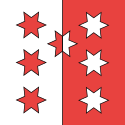
Back République des Sept-Dizains French Repubblica delle Sette Decanie Italian Republiek van de Zeven Gemeenten Dutch
Republic of the Seven Tithings | |||||||||
|---|---|---|---|---|---|---|---|---|---|
| 1571–1798 | |||||||||
 Map of the Valais, detail from a 1693 map of the Old Swiss Confederacy and its associates by Guillaume Sanson. | |||||||||
 The Swiss Confederacy in the 18th century, showing the "Seven Zenden of Valais", along with subject Lower Valais, as an associate state of the Confederacy | |||||||||
| Status | Associated to the Confederation | ||||||||
| Capital | Sion | ||||||||
| Official languages | German | ||||||||
| Regional languages | French | ||||||||
| Government | Federal republic[1] | ||||||||
| Landeshauptmann[2] | |||||||||
• 1571–1573 | Moriz Zum Brunnen[3] (first de facto) | ||||||||
• 1790–1798 | Jakob Valentin Sigristen[3] (last) | ||||||||
| Legislature | Diet | ||||||||
| Historical era | Early modern period | ||||||||
• Zehndenherrschaft (Republic) | 1571 | ||||||||
• declaration of independence | 1613 | ||||||||
• de jure independence | 1634 | ||||||||
• Incorporated into the Helvetic Republic | 1798 | ||||||||
| |||||||||
| Today part of | Switzerland | ||||||||
The Republic of the Seven Tithings[4] (German: Republik der Sieben Zenden, French: République des Sept-Dizains) was a state in what is now the Swiss canton of Valais during the early modern period, and an associate of the Old Swiss Confederacy.
The seven tithings (Zenden, dizains, Latin: decumae) of the Central and Upper Valais, listed orographically[clarification needed], were Goms, Brig, Visp, Raron, Leuk, Siders, and Sion. The six districts of the Lower Valais, known as "banners" (vexilla), were ruled as subject lands by the Republic. They only came to be referred to as dizains as they acceded to the Rhodanic Republic and the Swiss canton, during 1802–1815.
- ^ Himly, Auguste (1894). Histoire de la formation territoriale des états de l'Europe centrale (in French). Vol. 2. Hachette.
- ^ Landeshauptmann/Grand bailli in German, French and Italian in the online Historical Dictionary of Switzerland.
- ^ a b von Roten, Hans Anton (2008). Les Grands Baillis du Valais 1388 - 1798. Cahiers de Vallesia.
- ^ Stoddart, J. M., ed. (1889). "Valais". Encyclopædia Britannica. Vol. 24 (9th ed.). Philadelphia. p. 37.
{{cite encyclopedia}}: CS1 maint: location missing publisher (link)

